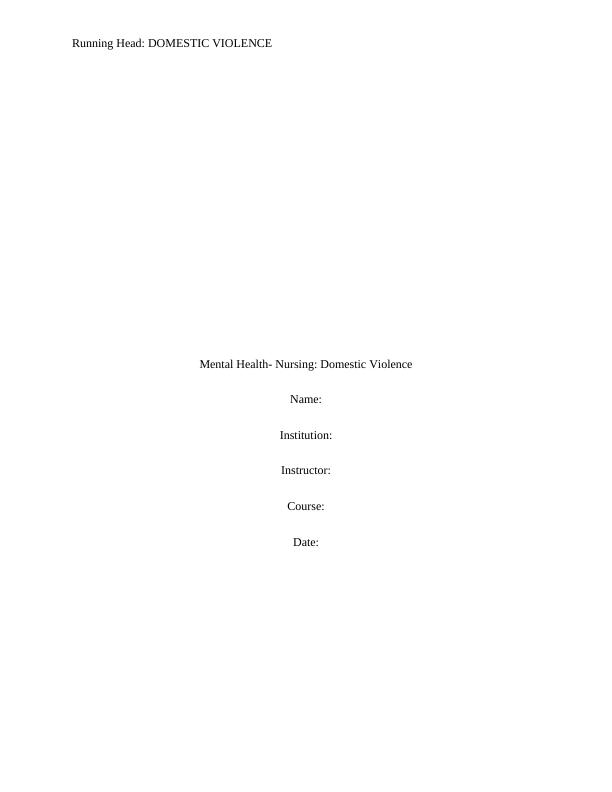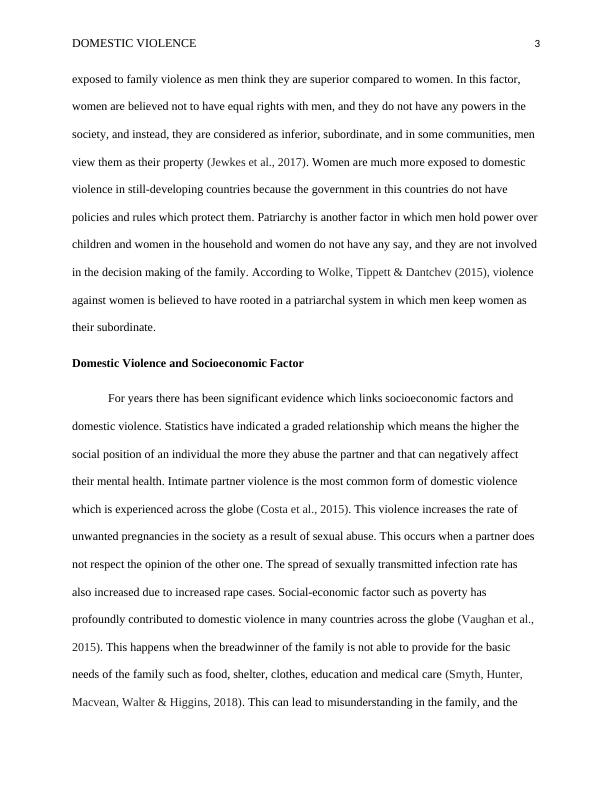Mental Health- Nursing: Domestic Violence
Added on 2023-06-07
10 Pages2747 Words436 Views
Running Head: DOMESTIC VIOLENCE
Mental Health- Nursing: Domestic Violence
Name:
Institution:
Instructor:
Course:
Date:
Mental Health- Nursing: Domestic Violence
Name:
Institution:
Instructor:
Course:
Date:

DOMESTIC VIOLENCE 2
Introduction
Domestic violence is the family abuse or domestic abuse by one person against another in
a domestic setting such as a family. It may involve physical, psychological, economic, social and
sexual abuse. Studies which have been conducted indicate that women, children and the elders in
the society are more exposed to domestic violence. Domestic violence may include acts like
forced marriage, human trafficking, rape and sexual assaults (Doidge, Higgins, Delfabbro &
Segal, 2017). Domestic violence is a type of abuse which involves injuring a spouse or a partner
but can also be a kid or a person from another family. It affects millions of lives across the globe
(Leach, Poyser & Fairweather‐Schmidt, 2017). Women are more exposed to domestic violence
because studies which were conducted indicated that one of every four women in the world is
exposed to domestic abuse and that the most significant percentage of people suffering from
domestic violence are women (O’Neal & Beckman, 2017). Despite this abuse by partners, only a
few cases are reported to the authorities, and that has led to the death of the victims if the abuser
is not warned to stop the malicious behavior.
Domestic violence against women is a significant obstacle while fighting for gender
equality in Australia and only a few nations seem to embrace it. Domestic violence against
women, children and elderly refer to the acts which are commitment violently against them and
they can cause harm to their bodies. Many factors cause domestic violence (Krnjacki, Emerson,
Llewellyn & Kavanagh, 2016). Family perspective is the first factor which indicates that the
behavior or actions of a family member are influenced by the responses which he/she gets back
from other family members. Children who are brought up by violent parents may end up
adopting this action in the future and thus abusing their partners because to them it is normal
(Eriksson & Mazerolle, 2015). The feminist perspective is another factor in which women are
Introduction
Domestic violence is the family abuse or domestic abuse by one person against another in
a domestic setting such as a family. It may involve physical, psychological, economic, social and
sexual abuse. Studies which have been conducted indicate that women, children and the elders in
the society are more exposed to domestic violence. Domestic violence may include acts like
forced marriage, human trafficking, rape and sexual assaults (Doidge, Higgins, Delfabbro &
Segal, 2017). Domestic violence is a type of abuse which involves injuring a spouse or a partner
but can also be a kid or a person from another family. It affects millions of lives across the globe
(Leach, Poyser & Fairweather‐Schmidt, 2017). Women are more exposed to domestic violence
because studies which were conducted indicated that one of every four women in the world is
exposed to domestic abuse and that the most significant percentage of people suffering from
domestic violence are women (O’Neal & Beckman, 2017). Despite this abuse by partners, only a
few cases are reported to the authorities, and that has led to the death of the victims if the abuser
is not warned to stop the malicious behavior.
Domestic violence against women is a significant obstacle while fighting for gender
equality in Australia and only a few nations seem to embrace it. Domestic violence against
women, children and elderly refer to the acts which are commitment violently against them and
they can cause harm to their bodies. Many factors cause domestic violence (Krnjacki, Emerson,
Llewellyn & Kavanagh, 2016). Family perspective is the first factor which indicates that the
behavior or actions of a family member are influenced by the responses which he/she gets back
from other family members. Children who are brought up by violent parents may end up
adopting this action in the future and thus abusing their partners because to them it is normal
(Eriksson & Mazerolle, 2015). The feminist perspective is another factor in which women are

DOMESTIC VIOLENCE 3
exposed to family violence as men think they are superior compared to women. In this factor,
women are believed not to have equal rights with men, and they do not have any powers in the
society, and instead, they are considered as inferior, subordinate, and in some communities, men
view them as their property (Jewkes et al., 2017). Women are much more exposed to domestic
violence in still-developing countries because the government in this countries do not have
policies and rules which protect them. Patriarchy is another factor in which men hold power over
children and women in the household and women do not have any say, and they are not involved
in the decision making of the family. According to Wolke, Tippett & Dantchev (2015), violence
against women is believed to have rooted in a patriarchal system in which men keep women as
their subordinate.
Domestic Violence and Socioeconomic Factor
For years there has been significant evidence which links socioeconomic factors and
domestic violence. Statistics have indicated a graded relationship which means the higher the
social position of an individual the more they abuse the partner and that can negatively affect
their mental health. Intimate partner violence is the most common form of domestic violence
which is experienced across the globe (Costa et al., 2015). This violence increases the rate of
unwanted pregnancies in the society as a result of sexual abuse. This occurs when a partner does
not respect the opinion of the other one. The spread of sexually transmitted infection rate has
also increased due to increased rape cases. Social-economic factor such as poverty has
profoundly contributed to domestic violence in many countries across the globe (Vaughan et al.,
2015). This happens when the breadwinner of the family is not able to provide for the basic
needs of the family such as food, shelter, clothes, education and medical care (Smyth, Hunter,
Macvean, Walter & Higgins, 2018). This can lead to misunderstanding in the family, and the
exposed to family violence as men think they are superior compared to women. In this factor,
women are believed not to have equal rights with men, and they do not have any powers in the
society, and instead, they are considered as inferior, subordinate, and in some communities, men
view them as their property (Jewkes et al., 2017). Women are much more exposed to domestic
violence in still-developing countries because the government in this countries do not have
policies and rules which protect them. Patriarchy is another factor in which men hold power over
children and women in the household and women do not have any say, and they are not involved
in the decision making of the family. According to Wolke, Tippett & Dantchev (2015), violence
against women is believed to have rooted in a patriarchal system in which men keep women as
their subordinate.
Domestic Violence and Socioeconomic Factor
For years there has been significant evidence which links socioeconomic factors and
domestic violence. Statistics have indicated a graded relationship which means the higher the
social position of an individual the more they abuse the partner and that can negatively affect
their mental health. Intimate partner violence is the most common form of domestic violence
which is experienced across the globe (Costa et al., 2015). This violence increases the rate of
unwanted pregnancies in the society as a result of sexual abuse. This occurs when a partner does
not respect the opinion of the other one. The spread of sexually transmitted infection rate has
also increased due to increased rape cases. Social-economic factor such as poverty has
profoundly contributed to domestic violence in many countries across the globe (Vaughan et al.,
2015). This happens when the breadwinner of the family is not able to provide for the basic
needs of the family such as food, shelter, clothes, education and medical care (Smyth, Hunter,
Macvean, Walter & Higgins, 2018). This can lead to misunderstanding in the family, and the

End of preview
Want to access all the pages? Upload your documents or become a member.
Related Documents
Domestic Violence: A Public Health Issue in Australialg...
|11
|2975
|425
Prevalence and Impact of Domestic Violence on Women in Australialg...
|16
|4395
|69
Hospitality Management: Sample Assignmentlg...
|7
|1455
|29
Domestic Violence: Prevention and Responseslg...
|10
|583
|263
Family violence is considered a gendered crimelg...
|5
|1108
|26
Women and Domestic Violence in Australialg...
|12
|1882
|367
